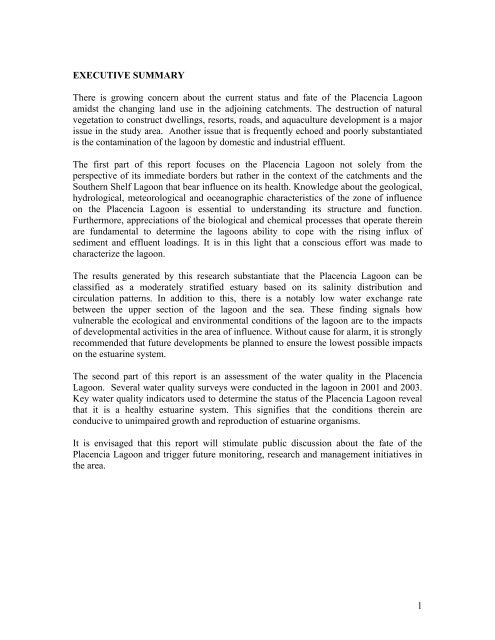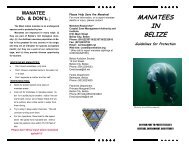The Placencia Lagoon - Coastal Zone Management Authority and ...
The Placencia Lagoon - Coastal Zone Management Authority and ...
The Placencia Lagoon - Coastal Zone Management Authority and ...
Create successful ePaper yourself
Turn your PDF publications into a flip-book with our unique Google optimized e-Paper software.
EXECUTIVE SUMMARY<br />
<strong>The</strong>re is growing concern about the current status <strong>and</strong> fate of the <strong>Placencia</strong> <strong>Lagoon</strong><br />
amidst the changing l<strong>and</strong> use in the adjoining catchments. <strong>The</strong> destruction of natural<br />
vegetation to construct dwellings, resorts, roads, <strong>and</strong> aquaculture development is a major<br />
issue in the study area. Another issue that is frequently echoed <strong>and</strong> poorly substantiated<br />
is the contamination of the lagoon by domestic <strong>and</strong> industrial effluent.<br />
<strong>The</strong> first part of this report focuses on the <strong>Placencia</strong> <strong>Lagoon</strong> not solely from the<br />
perspective of its immediate borders but rather in the context of the catchments <strong>and</strong> the<br />
Southern Shelf <strong>Lagoon</strong> that bear influence on its health. Knowledge about the geological,<br />
hydrological, meteorological <strong>and</strong> oceanographic characteristics of the zone of influence<br />
on the <strong>Placencia</strong> <strong>Lagoon</strong> is essential to underst<strong>and</strong>ing its structure <strong>and</strong> function.<br />
Furthermore, appreciations of the biological <strong>and</strong> chemical processes that operate therein<br />
are fundamental to determine the lagoons ability to cope with the rising influx of<br />
sediment <strong>and</strong> effluent loadings. It is in this light that a conscious effort was made to<br />
characterize the lagoon.<br />
<strong>The</strong> results generated by this research substantiate that the <strong>Placencia</strong> <strong>Lagoon</strong> can be<br />
classified as a moderately stratified estuary based on its salinity distribution <strong>and</strong><br />
circulation patterns. In addition to this, there is a notably low water exchange rate<br />
between the upper section of the lagoon <strong>and</strong> the sea. <strong>The</strong>se finding signals how<br />
vulnerable the ecological <strong>and</strong> environmental conditions of the lagoon are to the impacts<br />
of developmental activities in the area of influence. Without cause for alarm, it is strongly<br />
recommended that future developments be planned to ensure the lowest possible impacts<br />
on the estuarine system.<br />
<strong>The</strong> second part of this report is an assessment of the water quality in the <strong>Placencia</strong><br />
<strong>Lagoon</strong>. Several water quality surveys were conducted in the lagoon in 2001 <strong>and</strong> 2003.<br />
Key water quality indicators used to determine the status of the <strong>Placencia</strong> <strong>Lagoon</strong> reveal<br />
that it is a healthy estuarine system. This signifies that the conditions therein are<br />
conducive to unimpaired growth <strong>and</strong> reproduction of estuarine organisms.<br />
It is envisaged that this report will stimulate public discussion about the fate of the<br />
<strong>Placencia</strong> <strong>Lagoon</strong> <strong>and</strong> trigger future monitoring, research <strong>and</strong> management initiatives in<br />
the area.<br />
1



